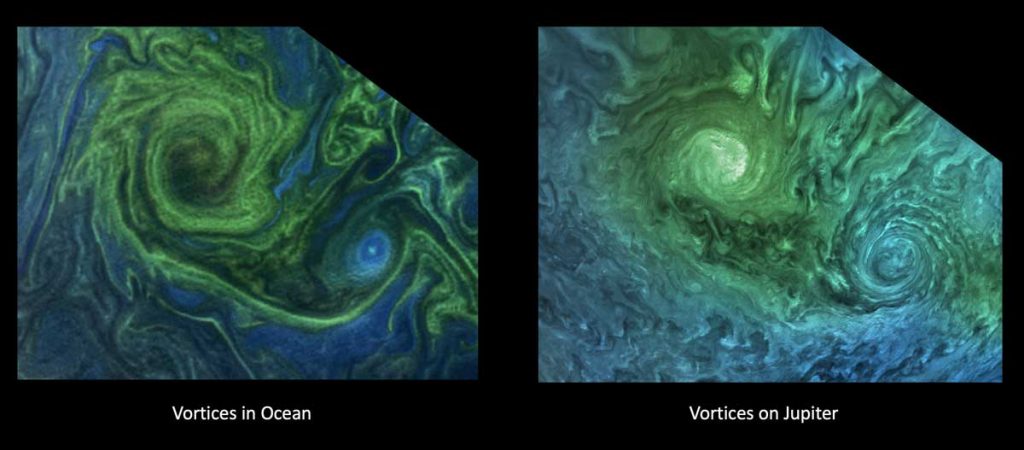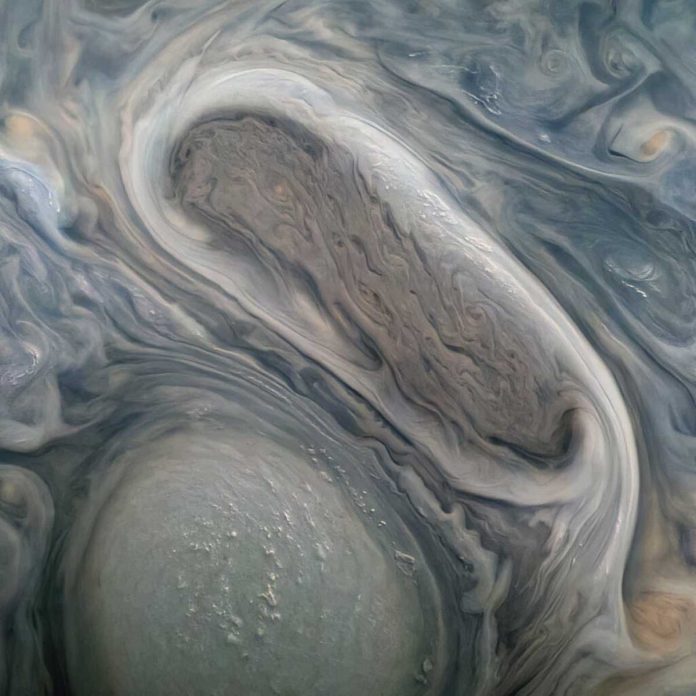NASA’s Juno mission to Jupiter at the American Geophysical Union Fall Meeting in New Orleans has discussed about sounds from a Ganymede flyby, magnetic fields and remarkable comparisons between Jupiter and Earth’s oceans and atmospheres.
Southwest Research Institute in San Antonio professor and Juno Principal Investigator, Scott Bolton has debuted a 50-second audio track that has been produced from data collected during the Juno mission’s close flyby of the Jovian moon Ganymede on June 7, 2021. Juno’s Waves instrument collected the data of the emission of electric and magnetic radio waves produced in Jupiter’s magnetosphere. That frequency has converted into audio range to make the audio track.
Bolton said “If you listen closely, you can hear the abrupt change to higher frequencies around the midpoint of the recording, which represents entry into a different region in Ganymede’s magnetosphere.”
University of Iowa in Iowa City and lead co-investigator for the Waves investigation, William Kurth thinks that the change in the frequency after closest approach happened because of the passing from the nightside to the dayside of Ganymede.
When Juno came close to Ganymede at the time of its 34th trip around Jupiter, Juno was within 645 miles of the moon’s surface and it was traveling at a relative velocity of 41,600 mph.
Jupiter is magnetic
NASA’s Goddard Space Flight Center in Greenbelt scientist Jack Connerney is the lead investigator of Juno’s magnetometer and he is also the mission’s deputy principal investigator. He and his team together has produced the most detailed map of the Jupiter’s magnetic field.
The scientists have compiled the data from 32 orbits during Juno’s prime mission to make the map. The map will provide new insights into the gas giant’s mysterious Great Blue Spot, a magnetic anomaly at the planet’s equator. Juno finds out that a change in the gas giant’s magnetic field has happened during the spacecraft’s five years in orbit. Juno recorded that the Great Blue Spot is drifting eastward at a speed of about 2 inches per second.
The Great Red Spot which is the long-lived atmospheric anticyclone just south of Jupiter’s equator is also drifting westward at a relatively rapid clip which has circled the planet in about four-and-a-half years.
The map provides us with the information that Jupiter’s zonal winds are pulling the Great Blue Spot apart. The zonal winds on the surface of the planet are reaching deep into the planet’s interior in this way.
The scientists also made the comparison between Jupiter and Earth’s magnetic field with the help of the map. The team suggested that dynamo action which is the mechanism of a celestial body to generate a magnetic field is creating metallic hydrogen in Jupiter’s interior, beneath a layer of “helium rain.”
The data collected by Juno will further reveal the mysteries of the dynamo effect of not only on Jupiter but on Earth too.

Oceans in Earth and Atmosphere in Jupiter
A postdoctoral fellow at Scripps Institution of Oceanography at the University of California, San Diego and a physical oceanographer, Lia Siegelman have studied the dynamics of Jupiter’s atmosphere. Siegelman has noticed that the cyclones at Jupiter’s pole appear to share similarities with ocean vortices that she had studied about.
Siegelman said “These are especially evident in high-resolution satellite images of vortices in Earth’s oceans that are revealed by plankton blooms that act as tracers of the flow.”
Scientists have produced simplified model of Jupiter’s pole that presents the geometric patterns of vortices that spontaneously emerge and survive forever. The basic geometrical configuration of Jupiter is allowing these intriguing structures to form.
Jupiter’s energy system is larger than Earth’s. The dynamics of the Jovian atmosphere will help us to understand the physical mechanisms of Earth as well.
The arm of Perseus
The team of researchers have released an image of Jupiter’s faint dust ring. The image has been taken from inside the ring looking out. Juno’s Stellar Reference Unit navigation camera has captured the picture. In the image the brightest of the thin bands and its neighbouring dark regions has been seen. This is linked to dust generated by two of Jupiter’s small moons named Metis and Adrastea. The arm of the constellation Perseus has also been captured in the image.

